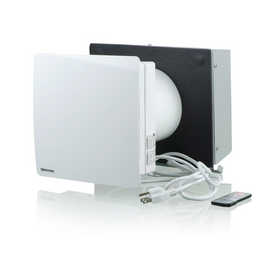
Sustainable Living Room Trends in 2020
Last Updated: Apr 11, 2025Trend forecasting is big business, especially when a decade is ending, and the predictions are focused on residential design. Type the keywords "sustainable," "living room," "trends," and "2020" into any browser and watch the prognosticators have a go. Sustainability is there but often buried within discussions of color, texture, pattern, and style influences. Isn't it about time that sustainable design became a necessity?
Probably one of the most used and high-traffic rooms in the house, the living room (or great room, or family room) serves multiple purposes. It's where we gather, converse, read, study, stream movies, nap on the couch, play with our pets, and more. Here's how to make your living room as sustainable as can be.
Table of Contents
- Living Room Color Trends
- Restyle Existing Furniture and Decor
- Repurpose Antique Lighting and Accessories
- Reclaimed Wood
- Non-toxic Carpeting
- Energy Efficient and Recyclable Televisions
- Give Fair Trade a Fair Home
- Made With Renewable Resources
- Healthy Home Furnishing Labels To Look For

Living Room Color Trends
Choosing that perfect living room color that celebrates your taste, style, and stand the test of time may seem daunting, but it's easier than you think. In 2020, designers are not only concentrating on one color but using complementary colors to bring more life to a room. Complimentary colors provide your living room with balance, comfort, and help introduce your personality and style.
Cloud white, soft grey, light beige, lavender, taupe, and powder blue can provide a robust, warm base that helps set the tone for the room. These colors are also an ideal choice if you are looking to brighten up a room that lacks natural light or make the room feel spacious. A living room should feel welcoming and comfortable, not dark and restrictive.
Next, select a friendly, playful tone to compliment your color selection. Light shades of charcoal, sky blue, red apple, sunny yellow, bright pumpkin orange, rose quartz, and sage green are perfect complementary colors. Using a color swatch, overlap your primary color on top of the complementary color. This will provide representation as to what the colors will look like once the walls are painted.
It's also important to consider your furniture and decor. While the conflict between these design decisions may not be a show stopper, they are details to consider. The same color swatches can be held up with furniture and decor in the background. The clashing of color with your furniture and decor will be more noticeable during the natural light of the daytime or in the evening when the room is lit with light fixtures. These are the ideal times to put your new color preferences to the test. Don't be afraid to let your style shine. Living rooms are a place to spend time with your family and friends. It's perfectly fine to be a little self-indulgent and ensure the room reverberates your style.

Restyle Existing Furniture and Decor
Many companies and designers are experimenting with how to restyle existing furnishings instead of relegating them to landfills. One designer is Carter Averbeck of whose company, Omforme, is dedicated to an eco-friendly, circular economy by restyling previously owned furnishings.
Averbeck argues that "older furnishings are built with quality materials and techniques not likely to be reproduced in today's market." His process of "optimistic rediscovery," he says, drives the studio's mission to create unique pieces that bring an individual sense of style in homeowners' living spaces.

Some homeowners, desiring unique character or personality in their living rooms, learn how to design and construct furniture. Seek local artists, furniture makers, and small companies for unique décor made with recycled materials. It not only supports their work but reduces embodied energy added through transportation.
Businesses in search of solutions to the tremendous amount of waste we generate are also figuring out how to make furnishings from recycled and repurposed materials. Rhianna Miller, an outdoor design and home improvement expert with Rubber Mulch, argues that "green furniture can be manufactured without harmful emissions, and will not be wasteful with our planet's materials."
Make sure the manufacturer isn't greenwashing you. If you're considering new furnishings with recycled content, look for a label or other information stating the exact percentage of recycled material. Please pay close attention to whether it's made from post-consumer or pre-consumer (post-industrial) recycled content.

Repurpose Antique Lighting and Accessories
Purchasing existing lighting, and accessories from antique shops and thrift stores is also an excellent way to repurpose used furnishings and keep them out of the waste stream. Matthias Alleckna, an energy analyst at EnergyRates.ca, is an advocate of smart lightbulbs, "which are proliferating and getting smarter. You can customize the warmth, the color, or the intensity. You can set controls so lighting responds to voice commands, your smartphone, or your Amazon Echo. There's a variety of smart bulbs from different brands in different price ranges," to meet every homeowner's needs. Many smart bulbs can be used with traditional lighting fixtures.

Reclaimed Wood
Reclaimed wood can be used for a variety of purposes throughout the living room. Discarded wood pieces can enjoy new life as:
- paneling
- accent walls
- doors
- hardwood floors
- wall art
- shelves
- bookcases
- planter boxes
- tables
- chairs
Reclaimed wood is abundant and can be purchased from local sellers or sourced from timbers, decking, farms, barns, factories, retired ships, wine barrels, boxcars, and more. Using reclaimed wood can also earn you credits towards LEED's 'materials and resources' criteria because it is considered recycled content. Cristina Miguelez, a remodeling specialist at Fixr.com, says, "The wood is beautiful, often old-growth species that can't be found anymore, so you're getting something that's unique and highly durable, as well as a sustainable conversation piece for your home."
Money Saving Home Improvement Products
Shop home improvement products that directly contribute to saving money through their use, whether through energy savings or lower maintenance costs.

Vents TwinFresh Comfo RA1-50-2 Ductless Energy Recovery Ventilator
Vents
In Stock

Stiebel Eltron Accelera 300 E Heat Pump Water Heater
Stiebel Eltron
In Stock

AFM Safecoat Almighty Adhesive Case of 12
AFM Safecoat
In Stock

Emporia Classic Level 2 48 AMP EV Charger UL Listed
Emporia
In Stock
2 Colors

Stiebel Eltron CON 300-2 Premium Wall-Mounted Convection Heater - 202030
Stiebel Eltron
Out of Stock

Santa Fe Compact70 Dehumidifier - 4044110
Santa Fe
In Stock

AFM Safecoat 3 in 1 Adhesive
AFM Safecoat
In Stock

Stiebel Eltron DHC-E 8/10-2 Plus Point-of-Use Electric Tankless Water Heater - 202145
Stiebel Eltron
In Stock

Stiebel Eltron Accelera 220 E Heat Pump Water Heater
Stiebel Eltron
In Stock

Stiebel Eltron CON 150-1 Premium Wall-Mounted Convection Heater - 202026
Stiebel Eltron
In Stock

Non-toxic Carpeting
While the trend during the 2000s may have been to replace carpeting altogether with hardwood or tile, carpets and rugs still held on to 60% of the market share. Sustainably minded homeowners were quick to make the switch; however, many homeowners were reluctant to give up the comfort and insulation provided by carpet manufacturers.
Many older carpets indeed contained volatile organic compounds (VOCs), phthalates, and endocrine-disruptors. Even new carpeting is known to contain carcinogens, including formaldehyde, acetone, toluene, ethylbenzene, and styrene. While none of this sounds reassuring thus far, many carpeting manufacturers fashion non-toxic carpet from natural fibers and wool. Look for carpeting made from jute, seagrass, sheep's wool, and sisal that is not manufactured or treated with toxic glues and chemicals.

Energy Efficient and Recyclable Televisions
While a TV may seem like an odd sustainability trend for your living room, TVs do have a lifespan and will need to be replaced over time. It's important to understand that not all TVs are created equal, and environmentally friendly choices do exist. Plasma TVs can emit 1,000 pounds of CO2 into the atmosphere and cost $70 per year in electricity for 5 hours of daily use. On the other hand, LEDs and OLEDs can operate for as little as $9.06 and $17.87 per year, respectively. If every TV, DVD player, and sound system in the United States were Energy Star, we could reduce annual greenhouse gas emissions by 2.8 billion pounds.
Less expensive, LCDs still appear on the market, with many containing mercury, unlike LED and OLED. Manufacturers like LG and Samsung have modernized assembly lines to use recycled and recyclable plastics and make components that are PVC- and BFR-free. Disassembly and recyclability at the end of life are increasing. Smaller and lighter packaging is also reducing energy and emissions from shipping. LG was presented with an award for Sustainability and Eco-design for it's LG 55E9 4k TV, which CES noted: "...made of eco-friendly and recyclable materials including natural glass."

Give Fair Trade a Fair Home
Cristina Miguelez also adds that in living rooms over the next decade, "It's all about the Fair Trade market. Sustainability is a broad term, and right now, the focus is on making sure that every item that you're acquiring is both environmentally friendly, but also produced in a fairly and sustainably. By looking for things labeled Fair Trade, you don't have to do as much digging" to determine the materials' provenance.
Miguelez also reminds homeowners to stay vigilant in their use of fossil fuels in the living room. "Using window treatments to control heat and light, getting energy audits done to stop energy leaks, and creating that tight building envelope can ensure a home is more sustainable at all times." Sounds advice as we enter a new decade of mindful sustainability.

Made With Renewable Resources
When buying new furnishings, ask a lot of questions and find reputable answers to make sure your new couch or lounge, curtains or, carpet have been sustainably sourced and produced. What materials were used to make the item? "Bamboo is a wonderfully renewable resource," Miller says. "It grows quickly, is extremely sturdy, and does not need to come from any natural habitats of endangered creatures or the Amazon rainforest."
In a Mydomaine.com article on 2020 living-room trends, Mikayla Keating, a designer with Decorist.com, said, "With wellbeing and sustainability on the rise, the biggest trend I see is the use of natural materials and textures. These humble materials like hemp, rattan, cane, and jute can add a huge impact to a space without feeling trendy or overdone."
Keating goes on to mention "biophilia," a design process that brings elements of nature—from increased natural light and views to the outdoors, to natural materials and textures—into our homes. "I predict that this trend will take the next decade by storm with its organic nature." Keating said.

Healthy Home Furnishing Labels To Look For
Ben Marshall, creative director, Hudson Valley Lighting Group (HVLG), emphasizes homeowners' increasing desire to add "an ethical component to their purchasing decisions. This desire manifests in warm, earthy, living room decor made with such sustainably harvested materials as acacia and rattan.
Ben Marshall, creative director, Hudson Valley Lighting Group (HVLG), emphasizes homeowners' increasing desire to add "an ethical component to their purchasing decisions. This desire manifests in warm, earthy, living room decor made with such sustainably harvested materials as acacia and rattan.
Forest Stewardship Council
When checking labels on new furnishings, look for Forest Stewardship Council certification, which makes sure the wood products in your furniture were harvested from sustainably managed forests. The Forest Stewardship Council (FSC) requires documentation of chain-of-custody along the entire supply chain.
Certi-Pur
Certi-Pur certification provides standardization for specific foam products. Greenguard Certification programs test for low VOC emissions. When purchasing furniture or décor made with textiles, look for Oeko-Tex certification. This certification ensures the following chemicals were severely limited or not used at all:
- brominated flame retardants
- chloro-organic toluenes and benzenes
- formaldehyde
- pesticides
- extractable heavy metals
- VOC emissions
- AZO dyes and other known carcinogenic and allergy-inducing dyes
- chlorinated phenols
- and organotin compounds
Sustainable Furnishing Council
Look for furnishings with a certification from the Sustainable Furnishing Council (SFC). SFC is a coalition of designers, retailers, and manufacturers dedicated to increasing awareness and adoption of environmental sustainability and helps consumers find healthy furnishings.
Scandinavia's Nordic Ecolabel (Svanen) Registry
Svanen works on behalf of the Swedish government to ecologically label over 20,000 products. Their database labels products in the housing and building sector, home products, lawn, and garden, electronics to the cars we drive. With a mandate of climate responsibility, their focus is on sustainable production and consumption.
Camille LeFevre
Camille LeFevre is an architecture and design writer based in the Twin Cities.
